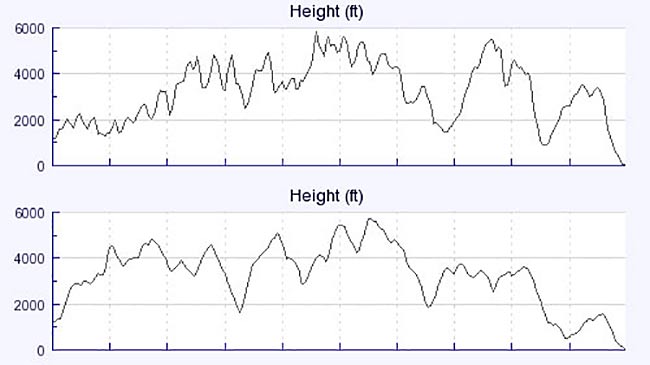
This week's tip comes from Pat Dower, and is from his blog at www.patdower.co.uk. Pat is a paragliding coach and writes for Cross Country


I was very interested to look at the tactical differences of two pilots during an XC recently. Both were from the same launch, at more or less the same time and were downwind flights with a bit of cross winding.
The top graph shows one pilot's height in feet against time with each block representing 40min. Ignore the first block-and-a-half as this was when the pilot was still soaring near launch. Once flying cross country, one feature to notice is the number of climbs that the pilot takes, including very small ones. This pilot is milking everything!
This bottom graph shows the other pilot flying the same route. In this case the time scale is in 24min intervals. This pilot took off later, when conditions were starting to become good and climbed out immediately. Compared to the first pilot, this pilot takes fewer climbs and gains more height in the climbs taken. This pilot is being more selective.
So which one is best?
The first pilot's XC took about 5.5hrs and the second about 4hrs. Further analysis would show that the second pilot climbed faster, because he ignored the weaker climbs in confidence that there would be better ones available. This is a cornerstone of speed-to-fly theory and helps the pilot cover the best distance, whist conditions allow it.
In this case it was actually the tortoise that won the day, covering an impressive 100+km, whilst the the hare was down at 80+km! What made the first pilot's flight even more impressive was that there was thick cirrus moving in and shutting the day down; it all pointed to fast being better than slow. What he did better than anyone else that day was avoid the patches of cirrus which were shutting off the thermals for the other pilots.
It just goes to show the delicious complexity of XC flying!

Join the family now by subscribing at
www.xcmag.com or call +44 (0) 1273 256 090
If you don't normally receive this newsletter sign up here
to have it delivered directly to your mailbox
Forward this to a friend ![]() share on Facebook
share on Facebook ![]() share on Twitter
share on Twitter